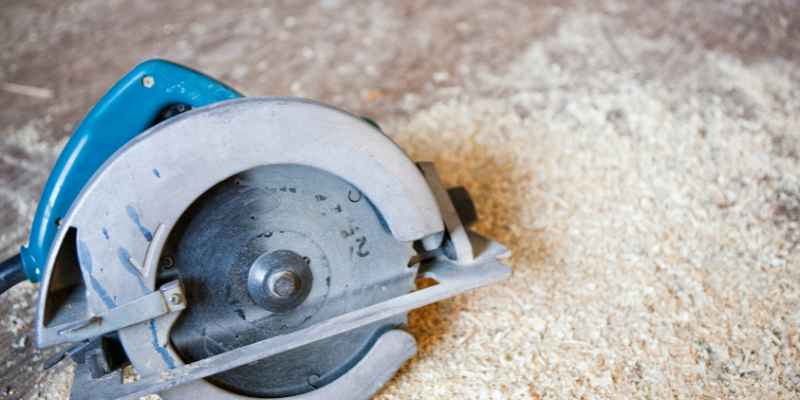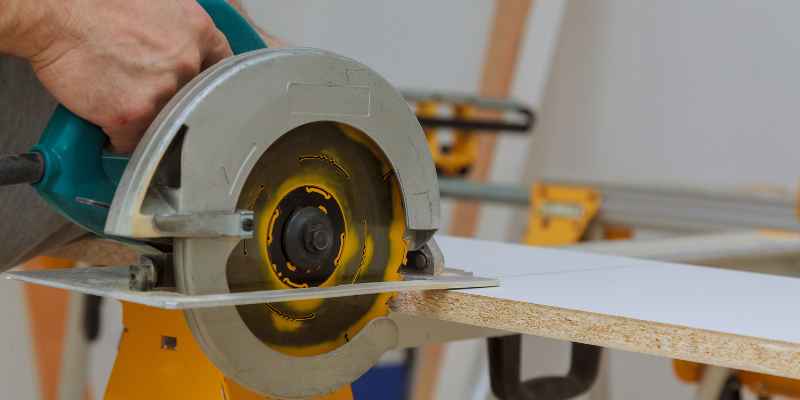There are many types of saws on the market, each designed for a specific purpose. Regarding woodworking, skill and circular saws are two of the most commonly used. Both have unique benefits that make them ideal for particular projects.
Here is a look at the difference between skill and circular saws so you can choose the right one for your next project. A skill saw is a handheld power tool with a thin, round blade. It is typically used for making straight cuts in wood or other materials.
The main advantage of using a skill saw is that it is very versatile and can be used for various tasks. On the other hand, a circular saw is a stationary power tool that features a large, rotating blade. It is used primarily for making rip cuts (cuts along the grain of the wood) or cross cuts (cuts across the grain of the wood).
Circular saws are generally more potent than skill saws and can handle stricter materials like metal or concrete.
There are a few critical differences between skill saws and circular saws. For starters, skill saws typically have a higher blade speed than circular saws. This means that they can cut through more challenging materials more efficiently.
Skill saws are also more lightweight and compact than their circular counterparts. This makes them ideal for tight spaces or quick, precise cuts. Another difference between the two types of saws is the depth of cut that they can achieve.
Circular saws typically make deeper cuts than skill saws, making them better suited for cutting lumber or large pieces of sheet metal. However, skill saws can still easily make shallow cuts, so they are versatile tools that can be used for various applications. Ultimately, the best way to decide which type of saw is right for you is to consider the specific project you’ll be using it for.
A circular saw is probably your best bet if you need to make deep cuts. But if you need a versatile tool that can handle both shallow and deep cuts, askillsaw might be the better choice.

Why is Circular Saw Called a Skill Saw?
A skill saw is a powerful tool most commonly used to make straight cuts in wood. It gets its name because it can be easily operated with one hand, allowing the user to “skillfully” guide it along a line or edge. The circular saw was invented in the late 18th century and has been a staple of carpentry and construction.
Today, there are many types of circular saws on the market, each designed for specific applications. But regardless of what kind of saw you use, the basics of how they work remain the same. At its most basic, a circular saw consists of a blade that spins around an arbor (axis).
The blade is mounted on an adjustable arm to be raised or lowered to change the depth of the cut. A motor powers the edge, usually activated by a trigger switch on the handle. Some models also have a variable speed feature that allows you to adjust the border speed to suit your particular material or application.
Most circular saws are handheld tools, but some larger stationary versions are meant to be used with two hands. These static models are often called table saws and are typically found in woodworking shops and other places where precision cuts are needed.
What is a Skill Saw Used For?
A skill saw is a handheld power tool used to make quick, straight cuts in wood. It can also cut other materials, such as metal or plastic. The saw has a blade mounted on an arm that pivots up and down.
This allows the blade to make various cuts, including crosscuts, rip cuts, and beveled cuts. The most common type of skill saw is the circular saw. This type of saw uses a circular blade to make quick, clean cuts in wood.
It is the most versatile type of skill saw and can be used for a variety of different projects. Another type of skill saw is the jigsaw. This type of saw uses a small, pointed blade to make intricate cuts in wood or other materials.
It is perfect for cutting curves or tight angles. The final type of skill saw is the reciprocating saw. This type of saw uses a long, thin blade that moves back and forth to make quick, rough cuts in wood or other materials.
It is often used for demolition work or when making massive cuts. No matter what project you are working on, there is a skill saw out there that can help you get the job done quickly and easily!
What is the Difference between a Rotary Saw And a Circular Saw?
Many people opt for a rotary or circular saw when it comes to home improvement projects. But what is the difference between these two types of saws? A rotary saw is a powerful tool that uses a rotating blade to cut through materials.
This type of saw is typically used for cutting metal or concrete. Rotary saws are also known as angle grinders or disc cutters. On the other hand, a circular saw uses a spinning blade to cut through wood and other materials.
Circular saws are handheld power tools that can be used for various tasks, such as cutting lumber, plywood, and laminate flooring.
Can You Cut a Tree With a Skill Saw?
A skill saw is a powerful handheld tool that can be used for various tasks, including cutting tree branches. While a skilled saw can cut through tree branches, exercising caution and following proper safety procedures is essential to avoid injury.
Skill Saw Corded
A corded skill saw is a powerful tool that can make quick work of many cutting jobs around the house. But before you start using one, it’s essential to understand how to handle and maintain the saw properly. In this blog post, we’ll give tips on how to safely and effectively use a corded skill saw safely and effectively.
When using a corded skill saw, always remember to wear proper eye and ear protection. The blades on these saws can spin at high speeds, so keeping your eyes protected from flying debris is essential. And because the motor on a corded skill saw can be pretty loud, it’s also a good idea to wear earplugs or headphones while using the tool.
Before making any cuts with your corded skill saw, double-check that the blade is secured correctly and that the power cord is not damaged. Once you’ve confirmed that everything is in working order, you’re ready to start cutting! When making cuts, follow your marked line as closely as possible – veering off course could damage your material or cause injury.
Once you’re finished making your cuts, unplug the saw and allow it to cool down before putting it away. Be sure to wipe down the blade and body of the saw with a damp cloth before storing it; this will help remove any built-up dust or debris.
Skill Saw Vs. Table Saw
Regarding woodworking, two of the most commonly used tools are the skill saw, and the table saw. Both have distinct advantages and disadvantages, so knowing which one to use for a particular project is essential. Here’s a look at the key differences between these two types of saws:
The most significant difference between a skill saw and a table saw is that a skill saw is portable, while a table saw is not. This means you can take a skill saw to different job sites or even use it in your garage or workshop at home. On the other hand, a table saw needs to be stationary – it must be bolted down to work properly.
Another key difference is that skill saws typically have smaller blades than table saws. This means that they can make narrower cuts but also that they aren’t as powerful as table saws when it comes to cutting through thick materials. Finally, skill saw blades spin much faster than a table saw blades.
This makes them ideal for making quick cuts in softwoods or plywood but can also lead to them being more dangerous if you’re not careful. So, which kind of saw should you use? If you need portability or plan on cutting in thinner materials, a skill saw is probably your best bet.
But if you’re working with thicker pieces of wood or need more power for more arduous cuts, opt for a table saw instead.
Skill Saw Vs. Miter Saw
When it comes to saws, there are a lot of options out there. But when it comes down to two specific types of saws – the skill saw and the miter saw – which one is better? Here’s a breakdown of each type of saw and their pros and cons.
The skill saw is a handheld power tool that can be used for various tasks, including cutting wood, metal, or tile. The most significant advantage of using a skill saw is its portability – you can take it wherever you go. Additionally, skill saws are typically less expensive than miter saws.
However, they can be more challenging to control and may require more practice. The miter saw is a stationary power tool specifically designed for making precise cuts at an angle – perfect for trim work or framing projects. Miter saws are generally easier to control than skill saws and produce cleaner cuts.
However, they’re more expensive and not as portable as skill saws.
Skil Circular Saw
When it comes to woodworking, a good circular saw is one of the essential tools in your arsenal. Not only does it allow you to make precise cuts, but it also makes the job a whole lot easier and faster. Skil is an excellent option if you’re in the market for a new circular saw.
In this post, we’ll take a closer look at the Skil Circular Saw and see what it has to offer. First and foremost, let’s talk about the blade. The Skil Circular Saw comes with a 7-1/4 inch carbide-tipped blade that can handle just about anything you throw at it.
It’s also worth noting that the blade is reversible, so if one side gets dulled, you can flip it over and use the other. The Skil Circular Saw doesn’t disappoint when it comes to power. It features a 15-amp motor that delivers power for even the most challenging projects.
And if you need to make any adjustments on the fly, there’s an easy-to-use depth adjustment lever right on top of the saw. One feature that sets this saw apart from others on the market is its dust blower system. This helps keep your work area clean by blowing away any dust or debris that might otherwise accumulate on your workpiece.
Trust us – once you’ve used a saw with this feature, you’ll never return! Last but not least, we should mention that this particular model (3400) comes with Skil’s revolutionary Smart Guard SystemTM. This innovative technology allows you to set up your cut before making it – meaning there’s no more guessing where your blade will end up!
Put: if precision and accuracy are essential to you (and they should be), this is worth checking out.
Jigsaw Vs. Skill Saw
When it comes to woodworking, one of the most common questions is: what’s the difference between a jigsaw and a skill saw? While both tools are designed for cutting wood, some key differences set them apart. Here’s a look at the key features of each tool, so you can decide which is suitable for your next project.
Jigsaw A jigsaw is a handheld power tool that uses a reciprocating blade to make curved or irregular cuts in wood. A clamp holds the edge in place, and the user guides the device along the desired cut line.
Jigsaws are ideal for making intricate cuts or curves in wood and can be used on various materials, including plastic and metal. Skill Saw A skill saw is also handheld, but it uses a circular blade to make straight cuts.
An arbor holds the blade in place, and the user guides the tool along the desired cut line. Skill saws are ideal for making long, straight cuts in wood – such as when cutting boards to length during construction projects. However, they cannot be used to create curves or irregular shapes like jigsaws.
Difference between Hacksaw And Circular Saw
There are many types to choose from when it comes to saws. Two of the most popular options are hacksaws and circular saws. So, what’s the difference between these two types of saws?
Hacksaws are smaller than circular saws and typically have a more limited cutting range. They’re ideal for making straight cuts in wood or metal and can be used for rough and satisfactory work. Hacksaws usually have replaceable blades, so you can easily switch out a dull blade for a new one.
Circular saws, on the other hand, are much larger than hacksaws and can handle stricter cutting jobs. They’re great for making significant cuts in wood or metal and can even be used to cut concrete or tile. Circular saws typically have fixed blades, so you’ll need to sharpen or replace the edge when it gets dull.

Milwaukee Circular Saw
There are many types of saws on the market, but the Milwaukee Circular Saw is one of the best. This saw is perfect for cutting through wood, metal, and even concrete. The blade on this saw is very sharp and can make precise cuts.
The handle on this saw is also very comfortable to use, which makes it easy to control.
Skilsaw Worm Drive
A worm drive is a type of gearbox used in some power tools. It is similar to a standard gearbox but uses a worm gear instead of spur gears. Worm drives are more durable than standard gearboxes and can handle higher loads.
However, they are also more expensive and less efficient than standard gearboxes. Worm drives are commonly used in power saws, such as circular and table saws. They are also used in other power tools, such as drill presses and lathes.
Worm drives can be found in both handheld and stationary power tools.
Conclusion
When it comes to saws, there are a lot of different types that serve other purposes. Skill and circular saws are two of the most popular types of saws on the market. So, what’s the difference between these two types of saws?
Skill saws are handheld power tools that can be used for various tasks, such as cutting wood, metal, or tile. They typically have a blade around 7 inches in diameter and can be swapped out for different blades depending on the task. Circular saws, on the other hand, are stationary tools that are designed specifically for cutting wood.
They usually have much larger blades (around 10 inches in diameter) and aren’t as versatile as skill saws in other materials like metal or tile.



3 thoughts on “Difference between Skill Saw And Circular Saw”